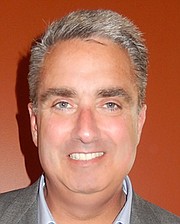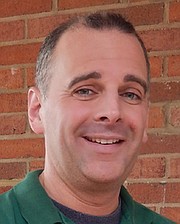Although the City of Fairfax’s sale of land to Loudoun County is long over, City mayoral candidate Tom Ammazzalorso is dredging it up as one of his campaign issues.
The sale was in December 2013, after the City decided that April to become water customers of Fairfax County. Escalating costs for the City to maintain and operate its own water system made doing so no longer economically feasible.
The switch to Fairfax Water saved the county more than $100 million for the eventual replacement of a 23-mile water-transmission line. It also resulted in a $5.61 million savings in water rates to the City’s residential and commercial customers.
Of the 800 acres sold to Loudoun, 600 comprised the Goose Creek Reservoir and 200 were the environs of the Goose Creek water treatment plant. The City received $30 million, but Ammazzalorso contends that “Whoever holds the land now is about to make a fortune” because it’s near Dulles International Airport and the Silver Line Metro’s last stop.
He also says the City didn’t have an independent appraisal done and shouldn’t have relied in part on the land’s valuation by its own, real estate tax assessor. Besides that, said Ammazzalorso, the City didn’t try to sell the property on the open market and there was limited public notice.
“At the time, I didn’t object to it because I thought the City was only selling the Loudoun water plant,” he said. “I didn’t realize how many acres came with it.”
Ammazzalorso also listed some items he said are in the proposed City budget: $1 million for a sidewalk on Route 123, a $10 million cut-through to Eaton Place via University Drive, a $36 million drainage project in Northfax, and $4 million-$6 million for bike lanes on Old Lee Highway.
“This is a tremendous amount of money that the City would have had if it had gotten a higher price for that land and it was developed.”
--Thomas Ammazzalorso
“This is a tremendous amount of money that the City would have had if it had gotten a higher price for that land and it was developed,” he said. “The city could have used the revenue from the homes and businesses that would have gone there and we could have reduced taxes.” And noting that the City used $20 million of the $30 million to hookup to Fairfax Water, he wondered what it did with the other $10 million.
However, Mayor Scott Silverthorne had information about and answers for every question. Regarding the land, he said his opponent’s statements are “flat wrong. The land is largely flood plain and in an EPA [Environmental Protection Area] and would have been very expensive to develop. Most of it is non-developable.”
It also received several appraisals. The reservoir, alone – which comprised three-fourths of the property – was valued by two different people at just $9 million and $6 million.
IN DECEMBER 2011, a developer (unsolicited) offered $21 for the whole thing. Professional engineer Bob Woodruff valued the reservoir at $10 million and the rest of the land at zero because the environmental reparation needed at the Beaver Creek Dam there – classified as “high hazard” – would have cost $12 million to $15 million to clean up the water treatment plant.
Fairfax Water offered $25 million for all the property, and Loudoun Water offered $30 million. And in March 2013, City Assessor Tom Reed valued it at $26 million. Silverthorne noted that it’s actually several miles away from the Silver Line and Loudoun County didn’t want to rezone the lake into anything else. And experts told the City that developing the land in a circle around the reservoir would be very expensive for roadways and piping.
So the City decided to take the best offer, avoid paying millions for reparation and not risk holding onto land that could prove too costly to ever redevelop. “The deal was fair to both the City and County,” said Silverthorne. “And if the City advertised the land purchase and prices came in as low as the project team suspected, the Loudoun Water Board would have reconsidered the selling price of $30 million.”
Regarding the money Ammazzalorso said the City is spending on certain projects, Silverthorne said they’re all funded by the state, mainly via NVTA (Northern Virginia Transportation Authority) dollars. Northfax is actually a transportation project, funded by VDOT and the federal government, and the money for Old Lee Highway isn’t just for bike lanes – which the residents requested – but to build complete streets and make Old Lee more beautiful and efficient. And the state will pay for half.
AS FOR THE $10 MILLION from the land sale Ammazzlorso wondered about, Silverthorne said it was used to pay off old debt on the City’s water bonds and give a tax break to the businesses. “Because of the water system and land sale, we were able to keep the C&I tax on businesses lower and added the sale proceeds toward leveraging additional transportation dollars from the NVTA. This enabled us to get 70 percent funding from the NVTA [for our transportation projects] and, as a result, we got $20 million over the last two years. And if we don’t take our fair share of NVTA money through these projects, the money would go to other Northern Virginia jurisdictions.”
When it came to informing the public about the water and land sale, the City actually received a Communications Award from the Virginia Municipal League for its transparency. During the course of the discussions, the City issued two brochures about it; sent an informational letter to every residential and business water customer, soliciting their input; held three public hearings and two public-outreach meetings; created a Web page and made public-service announcements. In addition, the City newsletter, Cityscene, ran six stories about it.
“Anytime people are unhappy with a decision, it’s easy for them to claim they were unaware or there was a lack of transparency and they thought the process was flawed.”
--Scott Silverthorne
“Anytime people are unhappy with a decision, it’s easy for them to claim they were unaware or there was a lack of transparency and they thought the process was flawed,” said Silverthorne. “But six, independently elected, City Council members of all political stripes, and myself as mayor, unanimously agreed this was the best decision for the City of Fairfax taxpayers.”

